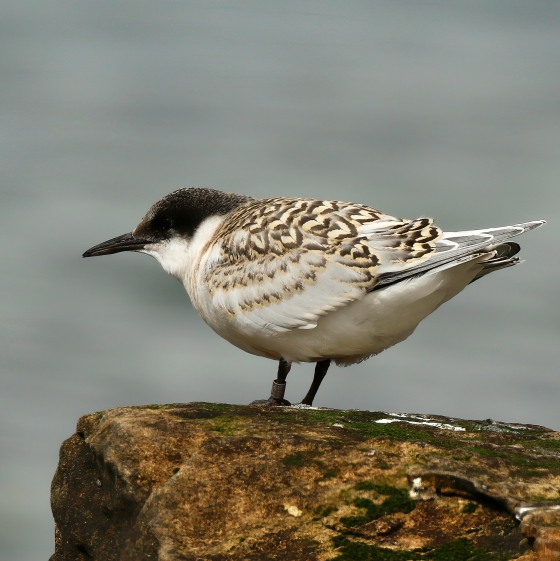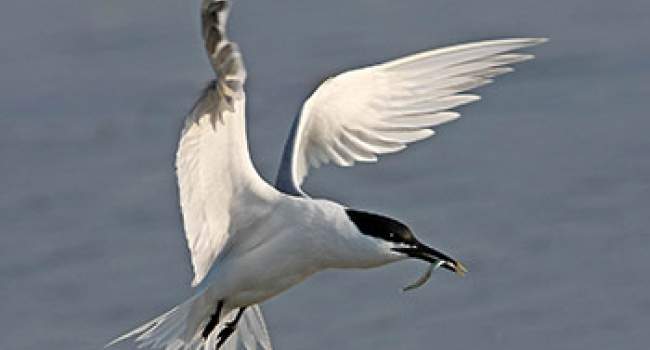Roseate Tern
Sterna dougallii (Montagu, 1813)
RS
 ROSTE
ROSTE  6140
6140

Family: Charadriiformes > Laridae

With its dark bill, silvery-grey upperparts and rosy-washed breast, the Roseate Tern is one of the UK’s rarest breeding birds.
The Roseate Tern is a very marine bird, spending most of its life at sea. It nests in colonies on low-lying rocky islets. The small British and Irish breeding populations are highly localised, with few pairs found nesting away from a handful of well-known sites.
Roseate Tern is a summer visitor to the UK, arriving in April and departing for West African during September. It is Red-listed in the UK as a Bird of Conservation Concern.
Identification
Roseate Tern identification is often difficult. The following article may help when identifying Roseate Tern.
SONGS AND CALLS
Listen to example recordings of the main vocalisations of Roseate Tern, provided by xeno-canto contributors.
Call
Develop your bird ID skills with our training courses
Our interactive online courses are a great way to develop your bird identification skills, whether you're new to the hobby or a competent birder looking to hone your abilities.
Browse training coursesStatus and Trends
Population size and trends and patterns of distribution based on BTO surveys and atlases with data collected by BTO volunteers.
CONSERVATION STATUS
This species can be found on the following statutory and conservation listings and schedules.
POPULATION CHANGE
Roseate Tern numbers declined substantially between the 1969–70 Census and Seabird 2000 (1998–2002), from 955 occupied nests to just 56 nests (JNCC 2022). The species is monitored by the Rare Breeding Birds Panel and, as a UK breeding species, it is now almost exclusively restricted as a breeding species to one island site in Northumberland. This site hosted 122 of the 125 breeding pairs recorded in 2019 and the 25 year trend is stable (Eaton et al. 2021).
DISTRIBUTION
Roseate Tern is a species of conservation concern owing to historic population declines. At the time of Bird Atlas 2007–11 breeding was concentrated in just three colonies: Coquet Island in northeast England and Rockabill and Lady’s Island Lake in the east of Ireland. More recently, Coquet Island has been devasted by the 2022 outbreak of avian influenza.
More from the Atlas Mapstore.
Occupied 10-km squares in UK
| No. occupied in breeding season | 13 |
| % occupied in breeding season | 0.4 |
European Distribution Map
DISTRIBUTION CHANGE
In Britain, colony loss has been greatest in the Firth of Forth, where there has been competition with Herring Gulls, low productivity, intermittent breeding and emigration to other areas. In Ireland, losses have been greatest at Strangford Lough and along the west coast.
| % change in range in breeding season (1968–72 to 2008–11) | -66.7% |
SEASONALITY
Roseate Terns is a scarce breeding species, present from May onwards; some birds seen on autumn passage into August and September.

Movement
Information about movement and migration based on online bird portals (e.g. BirdTrack), Ringing schemes and tracking studies.
RINGING RECOVERIES
View a summary of recoveries in the Online Ringing Report.
Foreign locations of birds ringed or recovered in Britain & Ireland

Biology
Lifecycle and body size information about Roseate Tern, including statistics on nesting, eggs and lifespan based on BTO ringing and nest recording data.
SURVIVAL & LONGEVITY
View number ringed each year in the Online Ringing Report
Maximum Age from Ringing 
|
23 years 10 months 8 days (set in 2004) 
|
Typical Lifespan 
|
8 years with breeding typically at 2 year |
Adult Survival 
|
0.855±0.047  
|
CODES & CLASSIFICATION
Ring size 
|
C2 |
Field Codes 
|
2-letter: RS | 5-letter code: ROSTE | Euring: 6140 |
For information in another language (where available) click on a linked name
Research
Interpretation and scientific publications about Roseate Tern from BTO scientists.
CAUSES AND SOLUTIONS
Causes of change
Recent increases at the main UK breeding site in Northumberland have been driven partly by immigration from Rockabill and Lady 's Island Lake in the Republic of Ireland (Seward et al. 2019 cited in Eaton et al. 2021), but the proportion of breeding birds that came from the Northumberland colony itself has risen from 20% to 60% between 2006 and 2019 (Eaton et al. 2021). However, the UK population remains well below the level in 1969–70. Longer term declines of the species are thought to have been driven mainly by hunting on its wintering grounds (Cabot 1996) although other factors may be responsible for local breeding declines including habitat loss, predation, disturbance and competition for nest sites (Avery et al. 1995, JNCC 2012). Intensive management programmes have been put in place to help protect the species including wardening at breeding sites and provision of nest boxes, and attempts to reduce the pressures affecting the wintering areas (Avery et al. 2010).
Links to more studies from ConservationEvidence.com
- A control taste aversion experiment on predators of roseate tern (Sterna dougallii) eggs
- Effectiveness of disturbance methods and egg removal to deter large gulls Larus spp. from competing with nesting terns Sterna spp. on Coquet Island RSPB reserve, Northumberland, England
- Invasive alien species as a threat to seabird populations: an account of habitat restoration on 'Ilhéu da Praia' (Graciosa, Azores) Special Protection Area
Read more studies about Roseate Tern on Conservation Evidence >
Would you like to search for another species?










Share this page